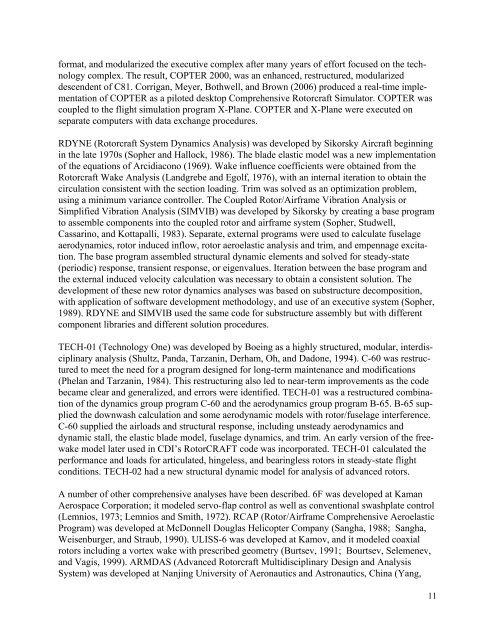A History of Rotorcraft Comprehensive Analyses
A History of Rotorcraft Comprehensive Analyses
A History of Rotorcraft Comprehensive Analyses
You also want an ePaper? Increase the reach of your titles
YUMPU automatically turns print PDFs into web optimized ePapers that Google loves.
format, and modularized the executive complex after many years <strong>of</strong> effort focused on the technology<br />
complex. The result, COPTER 2000, was an enhanced, restructured, modularized<br />
descendent <strong>of</strong> C81. Corrigan, Meyer, Bothwell, and Brown (2006) produced a real-time implementation<br />
<strong>of</strong> COPTER as a piloted desktop <strong>Comprehensive</strong> <strong>Rotorcraft</strong> Simulator. COPTER was<br />
coupled to the flight simulation program X-Plane. COPTER and X-Plane were executed on<br />
separate computers with data exchange procedures.<br />
RDYNE (<strong>Rotorcraft</strong> System Dynamics Analysis) was developed by Sikorsky Aircraft beginning<br />
in the late 1970s (Sopher and Hallock, 1986). The blade elastic model was a new implementation<br />
<strong>of</strong> the equations <strong>of</strong> Arcidiacono (1969). Wake influence coefficients were obtained from the<br />
<strong>Rotorcraft</strong> Wake Analysis (Landgrebe and Egolf, 1976), with an internal iteration to obtain the<br />
circulation consistent with the section loading. Trim was solved as an optimization problem,<br />
using a minimum variance controller. The Coupled Rotor/Airframe Vibration Analysis or<br />
Simplified Vibration Analysis (SIMVIB) was developed by Sikorsky by creating a base program<br />
to assemble components into the coupled rotor and airframe system (Sopher, Studwell,<br />
Cassarino, and Kottapalli, 1983). Separate, external programs were used to calculate fuselage<br />
aerodynamics, rotor induced inflow, rotor aeroelastic analysis and trim, and empennage excitation.<br />
The base program assembled structural dynamic elements and solved for steady-state<br />
(periodic) response, transient response, or eigenvalues. Iteration between the base program and<br />
the external induced velocity calculation was necessary to obtain a consistent solution. The<br />
development <strong>of</strong> these new rotor dynamics analyses was based on substructure decomposition,<br />
with application <strong>of</strong> s<strong>of</strong>tware development methodology, and use <strong>of</strong> an executive system (Sopher,<br />
1989). RDYNE and SIMVIB used the same code for substructure assembly but with different<br />
component libraries and different solution procedures.<br />
TECH-01 (Technology One) was developed by Boeing as a highly structured, modular, interdisciplinary<br />
analysis (Shultz, Panda, Tarzanin, Derham, Oh, and Dadone, 1994). C-60 was restructured<br />
to meet the need for a program designed for long-term maintenance and modifications<br />
(Phelan and Tarzanin, 1984). This restructuring also led to near-term improvements as the code<br />
became clear and generalized, and errors were identified. TECH-01 was a restructured combination<br />
<strong>of</strong> the dynamics group program C-60 and the aerodynamics group program B-65. B-65 supplied<br />
the downwash calculation and some aerodynamic models with rotor/fuselage interference.<br />
C-60 supplied the airloads and structural response, including unsteady aerodynamics and<br />
dynamic stall, the elastic blade model, fuselage dynamics, and trim. An early version <strong>of</strong> the freewake<br />
model later used in CDI s RotorCRAFT code was incorporated. TECH-01 calculated the<br />
performance and loads for articulated, hingeless, and bearingless rotors in steady-state flight<br />
conditions. TECH-02 had a new structural dynamic model for analysis <strong>of</strong> advanced rotors.<br />
A number <strong>of</strong> other comprehensive analyses have been described. 6F was developed at Kaman<br />
Aerospace Corporation; it modeled servo-flap control as well as conventional swashplate control<br />
(Lemnios, 1973; Lemnios and Smith, 1972). RCAP (Rotor/Airframe <strong>Comprehensive</strong> Aeroelastic<br />
Program) was developed at McDonnell Douglas Helicopter Company (Sangha, 1988; Sangha,<br />
Weisenburger, and Straub, 1990). ULISS-6 was developed at Kamov, and it modeled coaxial<br />
rotors including a vortex wake with prescribed geometry (Burtsev, 1991; Bourtsev, Selemenev,<br />
and Vagis, 1999). ARMDAS (Advanced <strong>Rotorcraft</strong> Multidisciplinary Design and Analysis<br />
System) was developed at Nanjing University <strong>of</strong> Aeronautics and Astronautics, China (Yang,<br />
11
















